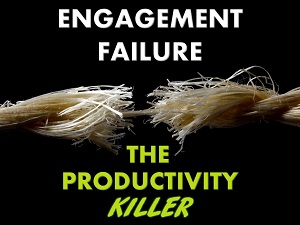“That’s the way it’s always been!”
“Things will never change…”
“Why should I care?”
How does your team feel when they come into the workplace each day?
Is there excitement and the urge to get started? Or are feet being dragged as we face yet another day of the same problems?
I truly do hope you’re the former.
For those that aren’t (or somewhere in between), the good news is – There’s always a better way.
Before we talk about solutions, we need to start by looking at the difference between the two situations and the impact it has.
Statistics & Polling giant Gallup recently released their findings of a global survey of levels of Employee Engagement.
Now, Employee Engagement is simply a term to describe a sense of belonging, care and ownership of business outcomes in relation to their goals.
Easy enough?
All participants from a wide range of industries, countries and positions in the organisation were ultimately ranked as either being Engaged, Not Engaged or Actively Disengaged.
For the purpose of this survey, “Gallup defines actively disengaged employees as those who “aren’t just unhappy at work; they’re busy acting out their unhappiness. Every day, these workers undermine what their engaged coworkers accomplish.””
You can only imagine what impact this has on Productivity not to mention the potential influence their actions have on other Team Members.
Employees who are Not Engaged aren’t lighting fires but aren’t contributing to their potential. They have a slightly less dramatic effect however do not lead the charge towards achieving your goals as an organisation.
The bad news is that the more employees you have in these two groups, the more negative impact to your Customers.
Let’s look at the numbers.
Australia’s figures were as follows:
ENGAGED NOT ENGAGED ACTIVELY DISENGAGED
24% (+/-3%) 60% (+/-4%) 16% (+/-3%)
In comparison, China’s in a worse position:
ENGAGED NOT ENGAGED ACTIVELY DISENGAGED
6% (+/-2%) 68% (+/-3%) 26% (+/-1%)
And the United States have more Engaged employees yet have more Actively Disengaged employees than Australia:
ENGAGED NOT ENGAGED ACTIVELY DISENGAGED
30% (+/-<1%) 52% (+/-<1%) 18% (+/-<1%)
Australia’s major obstacle lies right in the heart of, well, our heart.
Take a minute (yes, the full minute) to reflect on this finding: “only 19% of people in leadership positions report being engaged in their jobs”.
So, why would our teams be flat and drag themselves to task each day instead of jumping at the opportunity?
If we as leaders, managers, supervisors, business owners, etc. aren’t engaged, how can our teams be?
There’s enormous opportunity for improvement from within ourselves.
And changing will have an inevitable influence on those we lead and translate to motivation you’ve never seen before. I promise.
Here are five key characteristics and actions of leading for motivation and productivity.
- Have self-respect. Respect for you comes after you have it for yourself. In other words, walk the talk and treat others how you would like to be treated. Remember, what you walk past is what you ultimately accept.
- Care for people. Belonging to an organisation is for more than just collection of a salary. Think of how you can create a sense of community and ensure that consideration is given for people, not only their responsibilities.
- Set clear and achievable goals. Knowing what is expected of you is not only a basic requirement, it should be the guiding principles on the goals you set for your team – and they need to agree on what specifically is required of them along with the measurements to determine a job well done. Then, your team members need enough control and the ability to make decisions that will allow them to succeed. Make sure they have it.
- Know when to reprimand – This may vary by organisation however do not accept what is not acceptable. Feedback needs to be as close to the actual event as possible. It needs to be specific on what the unacceptable behaviour was and allow reflection on how this made you feel. Finally, sincerely remind that employee of their personal value and how the unwelcome behaviour is not to be repeated.
- Give praise, correctly. When applying new knowledge from recent training, when achieving the first milestone from a recently agreed goal or when a new team member demonstrates exceptional initiative in their role, be sure to give genuine appreciation. (See our article – Maintaining Motivation Through Recognition)
As you see the change taking place in your organisation, share these methods with your team and teach them how to follow these principles to motivate others.
Lastly, I want to share an example of a team that’s definitely NOT ENGAGED who are led through a Continuous Improvement transformation to become very productive.
Just a warning, this team is a little – different.
Leave a comment in our discussion forum. We’d like to hear how you’ve engaged your team members and the challenges you’ve had to overcome to convert others.
Courtesy of The Gordon – Geelong, Victoria, Australia

